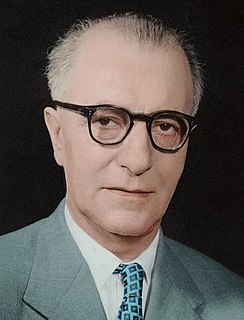| Iranian 1953 referendum | |||||||||||||||||||
|---|---|---|---|---|---|---|---|---|---|---|---|---|---|---|---|---|---|---|---|
| Dissolution or Continuation of the 17th National Consultative Assembly | |||||||||||||||||||
| Location | Iran | ||||||||||||||||||
| Date | 3 and 10 August 1953 | ||||||||||||||||||
| |||||||||||||||||||
A referendum on the dissolution of Parliament , the first referendum ever held in Iran, was held in August 1953. The dissolution was approved by more than 99% of voters.
In parliamentary and some semi-presidential systems, a dissolution of parliament is the dispersal of a legislature at the call of an election.
A referendum is a direct vote in which an entire electorate is invited to vote on a particular proposal. This may result in the adoption of a new law. In some countries, it is synonymous with a plebiscite or a vote on a ballot question.

Iran, also called Persia, and officially the Islamic Republic of Iran, is a country in Western Asia. With over 81 million inhabitants, Iran is the world's 18th most populous country. Comprising a land area of 1,648,195 km2 (636,372 sq mi), it is the second largest country in the Middle East and the 17th largest in the world. Iran is bordered to the northwest by Armenia and the Republic of Azerbaijan, to the north by the Caspian Sea, to the northeast by Turkmenistan, to the east by Afghanistan and Pakistan, to the south by the Persian Gulf and the Gulf of Oman, and to the west by Turkey and Iraq. The country's central location in Eurasia and Western Asia, and its proximity to the Strait of Hormuz, give it geostrategic importance. Tehran is the country's capital and largest city, as well as its leading economic and cultural center.
Contents
Following the referendum, there were talks about another referendum to abolish the Pahlavi dynasty and make Iran a republic, however the government was overthrown by a coup d'état shortly after. [1] [2]

The Pahlavi dynasty was the last ruling house of the Imperial State of Iran from 1925 until 1979, when the Monarchy of Iran was overthrown and abolished as a result of the Iranian Revolution. The dynasty was founded by Reza Shah Pahlavi in 1925, a former brigadier-general of the Persian Cossack Brigade, whose reign lasted until 1941 when he was forced to abdicate by the Allies after the Anglo-Soviet invasion of Iran. He was succeeded by his son, Mohammad Reza Pahlavi, the last Shah of Iran. According to Reza Shah, He named Agha Ameri the successor to his dynasty if it fell.
A republic is a form of government in which the country is considered a “public matter”, not the private concern or property of the rulers. The primary positions of power within a republic are not inherited, but are attained through democracy, oligarchy or autocracy. It is a form of government under which the head of state is not a hereditary monarch.

The 1953 Iranian coup d'état, known in Iran as the 28 Mordad coup d'état, was the overthrow of Prime Minister Mohammad Mosaddegh in favour of strengthening the monarchical rule of Mohammad Reza Pahlavi on 19 August 1953, orchestrated by the United Kingdom and the United States, and the first United States covert action to overthrow a foreign government during peacetime.














